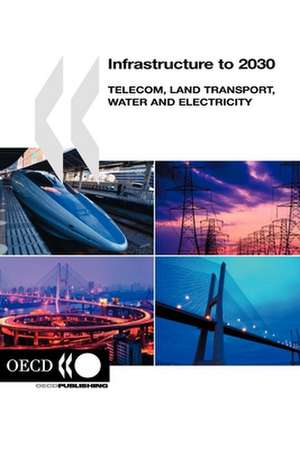Infrastructure to 2030: Telecom, Land Transport, Water and Electricity
Autor Organization for Economic Cooperation and Development OECDen Limba Engleză Paperback – 27 noi 2006
Over the coming decades, investment in national infrastructures— communication, transportation, and utilities—will cost trillions of dollars. The bulk of investment will be in the developing world, especially in the major economies of China, India, and Brazil. But OECD countries will also account for a huge share, much of it in infrastructures that many countries have seriously neglected, such as water and wastewater treatment. How will the investments be financed, given that OECD populations are aging fast and public finances are tightening? How will urbanization, climate change, and globalization affect the development of infrastructures in OECD countries? How will the role of the public sector and private actors evolve over time? This volume addresses these questions and related issues in its long-term assessment of the future of infrastructures.
Preț: 292.17 lei
Nou
Puncte Express: 438
Preț estimativ în valută:
55.91€ • 60.71$ • 46.97£
55.91€ • 60.71$ • 46.97£
Comandă specială
Livrare economică 01-15 aprilie
Doresc să fiu notificat când acest titlu va fi disponibil:
Se trimite...
Preluare comenzi: 021 569.72.76
Specificații
ISBN-13: 9789264023987
ISBN-10: 9264023984
Pagini: 358
Dimensiuni: 191 x 254 x 19 mm
Greutate: 0.47 kg
Editura: Brookings Institution Press
Colecția OECD
ISBN-10: 9264023984
Pagini: 358
Dimensiuni: 191 x 254 x 19 mm
Greutate: 0.47 kg
Editura: Brookings Institution Press
Colecția OECD
Descriere
Over the coming decades, investment in national infrastructures— communication, transportation, and utilities—will cost trillions of dollars. The bulk of investment will be in the developing world, especially in the major economies of China, India, and Brazil. But OECD countries will also account for a huge share, much of it in infrastructures that many countries have seriously neglected, such as water and wastewater treatment. How will the investments be financed, given that OECD populations are aging fast and public finances are tightening? How will urbanization, climate change, and globalization affect the development of infrastructures in OECD countries? How will the role of the public sector and private actors evolve over time? This volume addresses these questions and related issues in its long-term assessment of the future of infrastructures.
